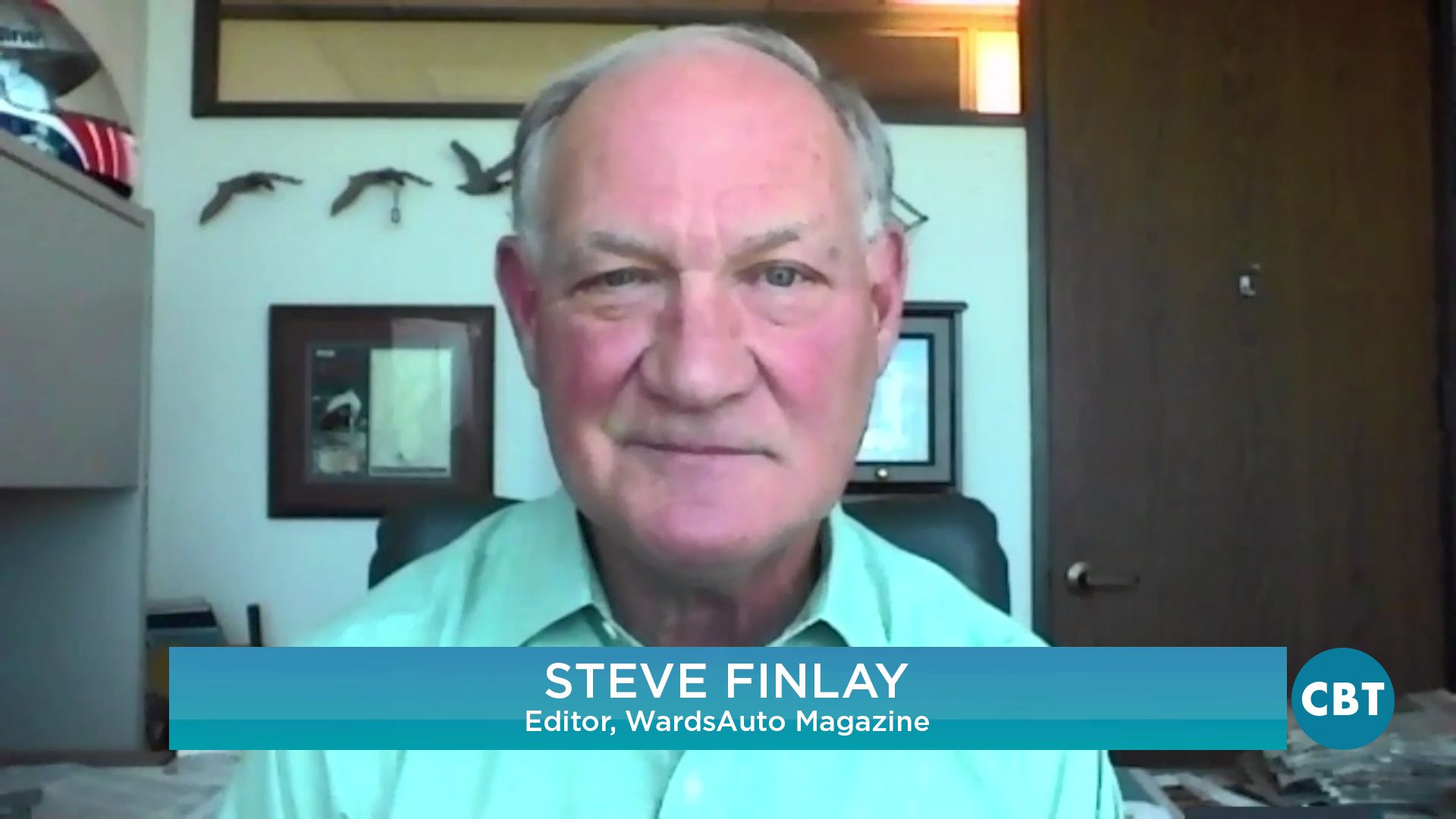We’re pleased to have Steve Finlay, Editor of Ward’sAuto Magazine, on CBT Automotive Network. Steve talks with us in regards to a recent article he wrote in the Ward’s Auto Magazine about crazy incentives that auto manufacturers offer to consumers. Steve says that some of the more common incentives range from deals for graduating college students to military members, however, there are some that are more outrageous than others, such as incentives for funeral directors. To hear more about these incentives and how dealerships are keeping track of them check out the full interview with Steve Finlay above.
VIDEO TRANSCRIPT:
Jim Fitzpatrick:
Hi everyone. I’m Jim Fitzpatrick. Thanks so much for joining us on another edition of CBT News. Today I’m excited to bring into the show Mr. Steve Finlay, who is the editor of Ward’s Auto Magazine. Steve, welcome to the show.
Steve Finlay:
Thank you Jim. Nice to be here, as always.
Jim Fitzpatrick:
Sure. So Steve, let’s talk about … A little bit, before we get started here on these other topics, about an article that you wrote in a Ward’s Auto recently about the crazy incentives that auto manufacturers offer out there to its consumers. What’d you find?
Steve Finlay:
Well, some of them are pretty crazy. Market Scan, which is a company out in California, tracks all incentives and there’s billions of dollars in incentives out there. So just keeping track of them is hard and a lot of dealers employ specific people to track incentives because there’s time elements to it to them and there’s eligibility to them. One of the favorites we were talking about was for funeral directors. At one time, Chrysler was offering $500 off a vehicle, assuming it wasn’t a hearse, but if you are a funeral director and you wanted a little extra incentive, you got it.
Jim Fitzpatrick:
How did they come upon funeral directors to say, oh, let’s give them a discount.
Steve Finlay:
And it’s kind of to die for. And then there was also an incentive Chrysler had, again, of another mother runner, which kind of bordered on double entendre there, but it was $1,000 to any mother that participated in a marathon. So there’s some odd ones out there and pretty specific ones, but usually the incentive … the main categories are college kids graduating and looking for a car, military, loyal customers to keep them in the fold, and then on the other side of that, the conquesting incentives to take a customer away from their current brand. So it goes all over the board.
Jim Fitzpatrick:
Which is, the conquest ones were always funny to me because you’re actually paying somebody if they trade in a competing brand, let’s say. But meanwhile, what are you doing for the guy or girl that’s trading in the same brand? You know what I mean? It would seem to me that they would be given much more of a bigger loyalty chunk.
Steve Finlay:
Yeah, that’s a good point. You’d think so. And, well, maybe it all evens out. If you take the incentive for being a loyal customer, you take the incentive for going to another brand, you’re still getting an incentive. I think that really what the market has done, and I’m not saying [inaudible 00:03:15], or anything like that, but [inaudible 00:03:17] come to expect a certain incentive. It’s part of the deal. [inaudible 00:03:27] a drug and there’s no rehab out there. So that’s just the cost of doing business. You could argue that if everybody took their incentives away, we wouldn’t have to give this extra money, but it’s a competitive market and that’s just not going to happen.
Jim Fitzpatrick:
So as you know that the manufacturers are still putting this harness on dealers with stair-step programs and many dealer group presidents and association presidents and such have said enough already with the stair-step, it’s really hurting our credibility with consumers. And so these incentives are all over the map, aren’t they?
Steve Finlay:
Yeah, well, you got to believe that stair-step incentives work to some extent or the manufacturers would not keep offering them. They do move the metal. Sometimes it puts dealers in a tough situation, especially at the end of the month where they’re doing deep discounts so they’re able to hit the quotas to get incentives because they don’t sell x number of cars and they think it’s all or nothing to a certain extent. I’ve met a lot of dealers who complained about stair-step incentives. I haven’t met many that say they’re a good idea, which is not to say that dealers who participate effortlessly … or, not effortlessly, but without a lot of hassle, anyway. Somebody’s got to like these programs.
Steve Finlay:
And I think Mike Jackson from Auto Nation pointed out, if somebody buys a product at the beginning of the month and their neighbor buys the same product at the end of the month and they compare notes as to who got the better deal, well the person at the end of the month’s going to have gotten the better deal and then the first person is going to be mad about that. I don’t know about that as a [inaudible 00:05:18]. I’m not sure how many neighbors go around comparing what they’ve paid for the same car.
Jim Fitzpatrick:
And besides, they lie anyway.
Steve Finlay:
But incentives are, again, out there. They’re not going to go away. They are little under 10% of MSRP. They nudged up a little this year from 9.6% to 9.8%. So it’s the cost of doing business. And they, by and large, work.
Jim Fitzpatrick:
Let’s change gears a little bit. We’re halfway through the year here and we’re still looking around a 17 million SAR. Do the people that you communicate with in the industry feel as though that’s pretty much where we’re going to end up for the year?
Steve Finlay:
Right. We’re just predicting about 16.8 million, maybe even 16.9 million. We’ve had … how many years? Four years of hit 17 million sales and above. So 16.8, we’ll take it. Anything, really. I mean, going from 17 to 16 would open some eyes, but it wouldn’t be catastrophic. I mean, this industry can be very healthy with the 16 million deliveries of like vehicles.
Jim Fitzpatrick:
That’s right. That’s right. Affordability, we spoke a little bit about that on your last visit to the show. $37,000 for the average price of a new car. Where are we going with that? That’s crazy.
Steve Finlay:
Well, a lot of times we’re going to higher loan terms, like 84 months and stuff like that. People still largely payment shop, as you know, so the cost of the vehicle is almost secondary. But again, it’s not that automakers are gouging customers. A lot of the average transaction price points we’re seeing now are because people are buying more vehicle. They’re buying the SUVs and CVs, which are more expensive. They’re buying the really tricked out trucks. I mean, trucks, when you’re spending $60,000 for a truck, that’s a luxury vehicle. And you know what Jim, that’s what they charging for a Jeep Gladiator mid-sized truck, and they can’t make enough of them.
Steve Finlay:
They base price at about $45,000 and the typical price is about $60,000, for a mid-sized truck. But it is a Jeep.
Jim Fitzpatrick:
That’s crazy. Where do we stand on the whole tariff situation? It seems like it’s kind of settling in much like the Tesla situation where people are like, oh yeah, there may be tariffs and no big deal depending on who you talk to. And that’s crazy.
Steve Finlay:
Well I think President Trump, and obviously I’m not privy to this, but it seems that some people have gotten to him, like a lot of Republicans and a lot of business people and said, auto tariffs are just a horrible idea. All it takes is a phone call with the NADA or the AIADA or anybody in the business. And it’s not … They’re not talking about self interest necessarily. Well they are, but this would have a profound effect on everybody. Customers would … You talk about affordability now, can you imagine the affordability of a vehicle if there’s the 25% tariff on those?
Steve Finlay:
And then, I think we talked about this before, the domestic automakers who wouldn’t have a tariff would then be able to nudge their prices up a little. Not to the point of-
Jim Fitzpatrick:
Yeah, 25%.
Steve Finlay:
… as high as the ones that have the tariffs, but they would nudge them up so everybody would be paying more for every vehicle.
Jim Fitzpatrick:
That’s right.
Steve Finlay:
And really unnecessarily. So you never can predict what’s going to happen, but it seems like tariffs are less of a big, big issue than they were before. Now that could change tomorrow.
Jim Fitzpatrick:
That’s for sure.
Steve Finlay:
Right now it’s a wait and see attitude, right?
Jim Fitzpatrick:
This President, regardless of what side of the aisle you’re on, is certainly fun to watch because you never know what he’s going to do at any given moment on these things.
Steve Finlay:
Yeah. I think he does ultimately listen to people if there’s enough of them and there’s political consequences that are raised. I mean, you look at all the Republicans in the Senate and the House that were appalled at the idea of those tariffs on Mexico that were proposed and those went away real quick.
Jim Fitzpatrick:
They did. They sure did. No question about it. Well, Steve Finlay, editor of Ward’s Auto Magazine, I want to thank you so much for joining us on CBT news. It is always a pleasure. So thanks again. I appreciate it.
Steve Finlay:
Same here, Jim.









